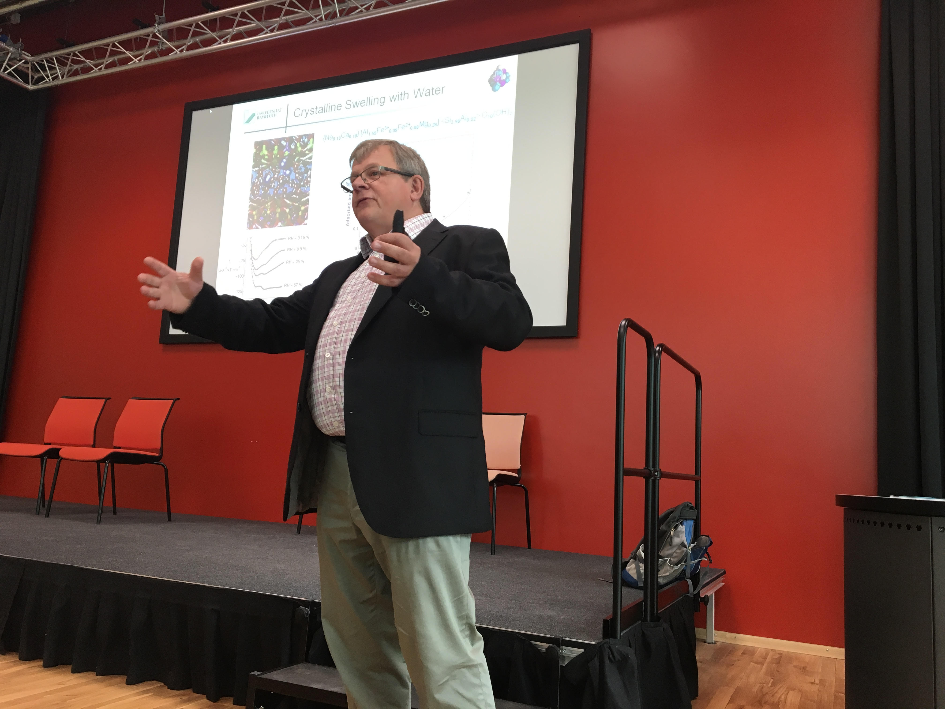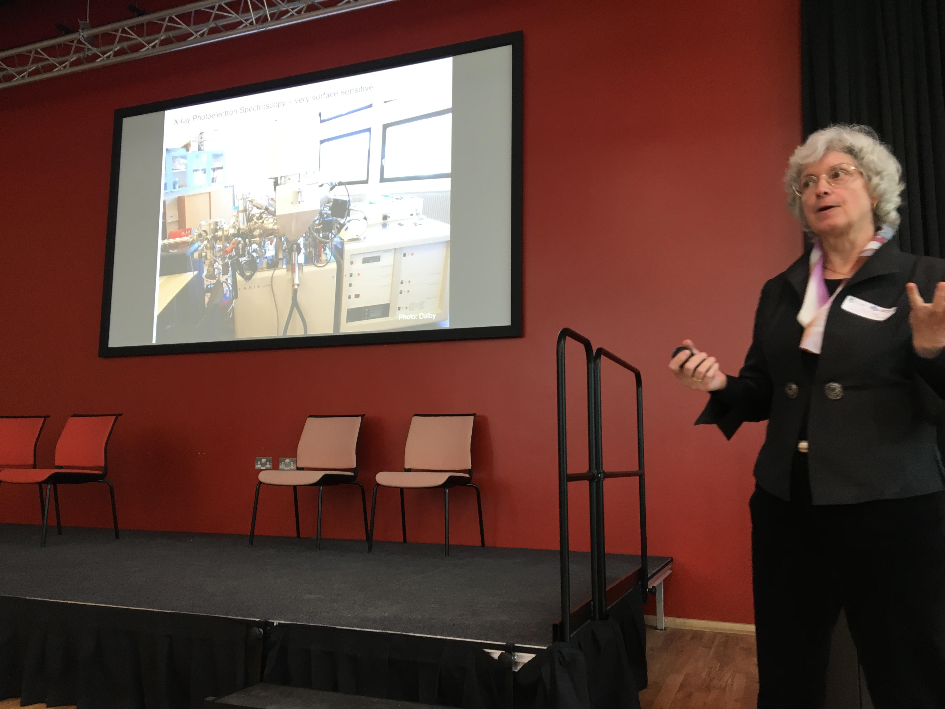Clay minerals in the natural and built environment: formation, chemistry and applications
This joint meeting between the ECG and the Clay Minerals Group, an interest group of the Mineralogical Society of UK and Ireland, was held on 17th May at Newcastle University, and consisted of an exciting programme of talks and posters to highlight how clay minerals affect the chemistry of the environment.
|
The meeting started with a keynote presentation from Professor Josef Breu (Universität Bayreuth), who took us on a journey through his career in clay minerals, from his initial interest sparked by fishing trips, through to his development of synthetic hectorite, which can be spray coated to make a perfect 2D thin film with applications as nanocomposites, catalyst supports and microporous hybrid materials.
The following talk by Kirill Shafran (BYK additives) described the development and applications of Laponite®, a synthetic magnesian smectite clay. It was invented by Dr Barbara Neumann in 1962 and, to this day, is used in agriculture, surface coatings industry and personal care products. It is said to have a benign ecological and biological profile, breaking down in the environment to its constituent parts, magnesium, lithium and silicates. The next speaker was ECG committee member David Owen (Treatchem Ltd), who provided a perspective on the industrial application of clay minerals. This included the use of kaolin in the paper industry (for improved brightness and smoothness) and the use of bentonite to help remove contrary products from pulp. He illustrated his talk with examples from his career of troubleshooting issues that involved a diverse range of fields such as impurities causing problems with paper quality and working with effluent treatment plants. |
Nikolaos Apeiranthitis (Durham University) described how clay minerals play an important role in the recovery of oil from reservoir rocks, and how their presence might allow low salinity fluids to be used as the injectate.
This was followed by two talks on using Fe-bearing clay minerals to treat emerging contaminants in wastewater treatment plants. Wojciech Mrozick (Newcastle University) explained how redox-active reactive clays could remove micropollutants such as pharmaceuticals or endocrine disruptors from wastewater via oxidation or reduction mechanisms.
Panagiota Adamou (Newcastle University) showed that while peroxide treatment caused a slight reduction in the amount of bacterial DNA in wastewater, combined peroxide and Fe-bearing clay minerals (nontronite) treatment of wastewater produced a much bigger decrease. In particular, a notable reduction in the observation of three antimicrobial resistant bacterial genes. Panagiota was awarded the prize for best student presentation.
After lunch, Professor Susan Stipp provided the second keynote presentation. Her work exploring the structure of clays aims to understand their properties in order to elucidate how chemicals behave once released into the environment. For example, clays may control the fate of pesticides in agriculture, sorbing and transforming toxic compounds, adsorbing nutrients which support plant growth, and remediating contaminants in some cases, such as the application of cationic clays including green rust.
This was followed by two talks on using Fe-bearing clay minerals to treat emerging contaminants in wastewater treatment plants. Wojciech Mrozick (Newcastle University) explained how redox-active reactive clays could remove micropollutants such as pharmaceuticals or endocrine disruptors from wastewater via oxidation or reduction mechanisms.
Panagiota Adamou (Newcastle University) showed that while peroxide treatment caused a slight reduction in the amount of bacterial DNA in wastewater, combined peroxide and Fe-bearing clay minerals (nontronite) treatment of wastewater produced a much bigger decrease. In particular, a notable reduction in the observation of three antimicrobial resistant bacterial genes. Panagiota was awarded the prize for best student presentation.
After lunch, Professor Susan Stipp provided the second keynote presentation. Her work exploring the structure of clays aims to understand their properties in order to elucidate how chemicals behave once released into the environment. For example, clays may control the fate of pesticides in agriculture, sorbing and transforming toxic compounds, adsorbing nutrients which support plant growth, and remediating contaminants in some cases, such as the application of cationic clays including green rust.
Professor Breu (left) and Professor Stipp (right) giving the keynote presentations.
Following the keynote, Harry Brooksbank (Newcastle University) talked about his research into Fe-bearing clay minerals to treat nitroaromatic contaminants.
In a completely different environmental application, Amy Lewis (University of Sheffield) described some preliminary findings from her research on how basalts can be applied to soils to enhance natural weathering and remove carbon dioxide.
Bhoopesh Mishra (University of Leeds) gave an invited talk on his work using X-ray absorption spectroscopy to evaluate how clay minerals form and their environmental impacts. For example, the formation of aluminium and iron colloids in lakes can control phosphorus cycling, and organic matter coated iron or manganese oxides and clays are the main sink for mercury in surface waters.
The last presentation of the day was given by Jing Zhang (University of Manchester) on the behaviour of molybdenum in iron-rich environmental systems such as acid mine drainage.
Many excellent posters on clay minerals were presented at the meeting, with relevance to the oil industry, antimicrobials, remediation and architectural conservation. The prize for best student poster was awarded to Jeffery Paulo Perez (GFZ German Research Centre for Geosciences).
Overall, it was a thoroughly enjoyable day, with plenty of questions from the audience and opportunities for discussions and networking, and very interesting to hear about environmental chemistry from a mineralogical perspective. While clay minerals consist of very small particles, their importance should not be overlooked.
In a completely different environmental application, Amy Lewis (University of Sheffield) described some preliminary findings from her research on how basalts can be applied to soils to enhance natural weathering and remove carbon dioxide.
Bhoopesh Mishra (University of Leeds) gave an invited talk on his work using X-ray absorption spectroscopy to evaluate how clay minerals form and their environmental impacts. For example, the formation of aluminium and iron colloids in lakes can control phosphorus cycling, and organic matter coated iron or manganese oxides and clays are the main sink for mercury in surface waters.
The last presentation of the day was given by Jing Zhang (University of Manchester) on the behaviour of molybdenum in iron-rich environmental systems such as acid mine drainage.
Many excellent posters on clay minerals were presented at the meeting, with relevance to the oil industry, antimicrobials, remediation and architectural conservation. The prize for best student poster was awarded to Jeffery Paulo Perez (GFZ German Research Centre for Geosciences).
Overall, it was a thoroughly enjoyable day, with plenty of questions from the audience and opportunities for discussions and networking, and very interesting to hear about environmental chemistry from a mineralogical perspective. While clay minerals consist of very small particles, their importance should not be overlooked.




